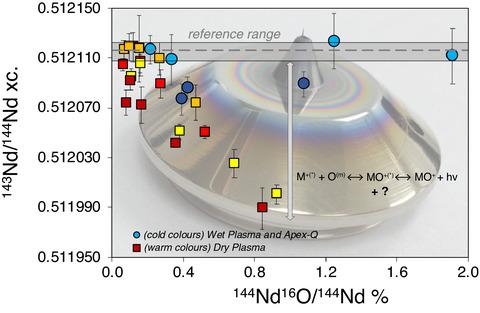当前位置:
X-MOL 学术
›
Geostand. Geoanal. Res.
›
论文详情
Our official English website, www.x-mol.net, welcomes your
feedback! (Note: you will need to create a separate account there.)
Oxide Formation and Instrumental Mass Bias in MC-ICP-MS: An Isotopic Case Study of Neodymium
Geostandards and Geoanalytical Research ( IF 2.7 ) Pub Date : 2021-03-20 , DOI: 10.1111/ggr.12381 Evelyn Frères 1 , Dominique Weis 1 , Karla Newman 2 , Marghaleray Amini 1 , Kathy Gordon 1
Geostandards and Geoanalytical Research ( IF 2.7 ) Pub Date : 2021-03-20 , DOI: 10.1111/ggr.12381 Evelyn Frères 1 , Dominique Weis 1 , Karla Newman 2 , Marghaleray Amini 1 , Kathy Gordon 1
Affiliation

|
High rates of oxide formation affect the magnitude and behaviour of instrumental mass bias for Nd isotopic measurements performed with multi-collector inductively coupled plasma-mass spectrometry (MC-ICP-MS) instruments, causing the traditional correction methods (e.g., internal and external normalisation) to fail. Here, we investigate the instrumental conditions that govern oxide formation and provide an extensive data set describing how different oxide formation rates affect the measurement error of Nd isotopic ratios. Results are reported for several instrumental set-ups including wet and dry plasma, different introduction methods, the addition of N2, and various sampler and skimmer cone geometries. The differences in the behaviour of Nd isotopic ratios observed for dry and wet plasma require several reaction mechanisms to explain why oxide formation is associated with a non-linear mass bias for some rare earth elements. We developed a simple mathematical model to describe the behaviour of Nd isotopic ratios for a range of oxide formation rates and different instrumental settings and present a qualitative model that predicts the isotopic offsets of Nd ratios based on the cumulative contributions of the major sources of mass bias. A series of analytical recommendations for the determination of accurate and precise Nd ratios by MC-ICP-MS is presented.
中文翻译:

MC-ICP-MS 中的氧化物形成和仪器质量偏差:钕的同位素案例研究
氧化物形成的高速率影响使用多接收器电感耦合等离子体质谱 (MC-ICP-MS) 仪器进行 Nd 同位素测量的仪器质量偏差的大小和行为,导致传统的校正方法(例如,内部和外部归一化) ) 失败。在这里,我们研究了控制氧化物形成的仪器条件,并提供了一个广泛的数据集,描述了不同的氧化物形成速率如何影响 Nd 同位素比率的测量误差。报告了几种仪器设置的结果,包括湿等离子体和干等离子体、不同的引入方法、添加 N 2,以及各种采样器和截取锥几何形状。在干和湿等离子体中观察到的 Nd 同位素比率行为的差异需要几种反应机制来解释为什么氧化物形成与某些稀土元素的非线性质量偏差有关。我们开发了一个简单的数学模型来描述在一系列氧化物形成速率和不同仪器设置下 Nd 同位素比率的行为,并提出了一个定性模型,该模型基于质量偏差的主要来源的累积贡献预测 Nd 比率的同位素偏移. 提出了一系列通过 MC-ICP-MS 确定准确和精确的 Nd 比率的分析建议。
更新日期:2021-03-20
中文翻译:

MC-ICP-MS 中的氧化物形成和仪器质量偏差:钕的同位素案例研究
氧化物形成的高速率影响使用多接收器电感耦合等离子体质谱 (MC-ICP-MS) 仪器进行 Nd 同位素测量的仪器质量偏差的大小和行为,导致传统的校正方法(例如,内部和外部归一化) ) 失败。在这里,我们研究了控制氧化物形成的仪器条件,并提供了一个广泛的数据集,描述了不同的氧化物形成速率如何影响 Nd 同位素比率的测量误差。报告了几种仪器设置的结果,包括湿等离子体和干等离子体、不同的引入方法、添加 N 2,以及各种采样器和截取锥几何形状。在干和湿等离子体中观察到的 Nd 同位素比率行为的差异需要几种反应机制来解释为什么氧化物形成与某些稀土元素的非线性质量偏差有关。我们开发了一个简单的数学模型来描述在一系列氧化物形成速率和不同仪器设置下 Nd 同位素比率的行为,并提出了一个定性模型,该模型基于质量偏差的主要来源的累积贡献预测 Nd 比率的同位素偏移. 提出了一系列通过 MC-ICP-MS 确定准确和精确的 Nd 比率的分析建议。











































 京公网安备 11010802027423号
京公网安备 11010802027423号